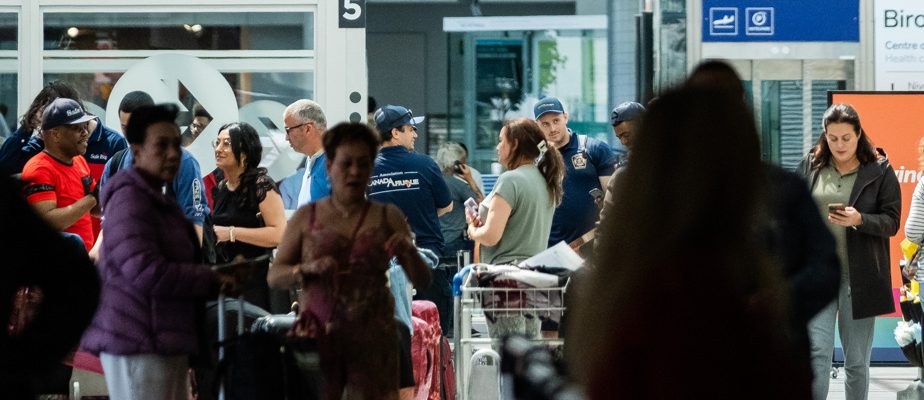The closure of Roxham Road was intended to curb the flow of migrants. Quite the opposite happened. Asylum requests continued their momentum, and already exceeded, in November, the record set for 2022.
Data released Wednesday, covering the first 11 months of the year, show that Quebec welcomed 59,735 asylum seekers, compared to 51,635 for the same period in 2022, an increase of 16%. For all of 2022, 58,805 asylum seekers arrived in Quebec.
Quebec is still the main point of arrival for asylum seekers, with 46% of Canada’s total demands. Ontario is the second largest destination, with 43%. Ontario’s catch-up is spectacular. In 2022, the neighboring province received more than half as many requests as Quebec, i.e. 26% compared to 64%. This year, they are almost tied.

This reversal of trend is largely explained by the mode of entry of applicants, who arrive in Canada by plane rather than by land.
The pressure exerted in 2023 by this new mode of entry should, however, ease because the Canadian Immigration Department announced on December 15 that it was ending a program which consisted of accelerating the issuance of visas. visitor for countries where delays were very long. The result was a sudden increase in the number of asylum requests after leaving the plane.
But for now, pressures are still as strong on aid organizations, and the number of homeless asylum seekers is increasing in the Montreal region.
Filled sites
“We have a lot of requests every day from people who are at risk of homelessness,” says Eva Gracia-Turgeon, director of Foyer du monde, a shelter for asylum seekers in Montreal.
The road is different and the socio-economic portrait of the applicants is a little different, but the pressure is still there.
Eva Gracia-Turgeon, director of Foyer du monde
Stephan Reichhold, director of the Consultation Table of Organizations Serving Refugees and Immigrants (TCRI), estimates that 5,000 to 10,000 applicants are added each month in Quebec.
With a capacity of 1,150 people, the two sites managed by the Regional Program for the Reception and Integration of Asylum Seekers (PRAIDA) have been full since the start of the year. The organization, which reports to the government of Quebec, welcomed 10,976 people in 2023, less than the 16,204 last year, but “the duration of stays was longer than the usual two or three weeks,” reports the spokesperson, Carl Thériault.
To accommodate those who have no place to go, the federal government continues to rent rooms in hotels in the metropolis. But all these accommodations are only temporary. People have to leave after a month or two, only to find themselves in the middle of a housing crisis.
“We will have to think about accommodation, not just temporary, but in the medium term,” says Stephan Reichhold, of the TCRI, who cites the project to build a reception center with 800 places for asylum seekers near from Pearson Airport, Ontario.
Fear of being deported
In Quebec, since the closure of Roxham Road, asylum requests have exploded at Montreal-Trudeau airport: 2,780 in November 2023, compared to 1,420 in November 2022.

PHOTO JOSIE DESMARAIS, LA PRESSE ARCHIVES
Roxham Road, the day it closed, March 25
A small number of migrants continue to enter via the land border, making their way through the woods, according to several organizations consulted. The additional protocol to the Safe Third Country Agreement, concluded between Ottawa and Washington, allows them to legally submit a request for asylum in Canada within 14 days of their “irregular” entry into the country.
People don’t really say how they arrived in Quebec because they are afraid of being deported. They wait 14 days and then they show up. But it is very difficult for them to have access to support services. They escape the system.
Stephan Reichhold, director of the Table de concertation des organizations serving refugees and immigrants
“We are creating laws that make people more precarious and that make them de facto ineligible for what would normally have been accessible to them,” laments Eva Gracia-Turgeon, of Foyer du monde.
No role for Quebec
According to PRAIDA data, the majority of asylum seekers arriving this year come from Mexico, whose citizens can enter Canada without a visa, Colombia, Haiti, Turkey and Venezuela.
To have refugee status, giving access to permanent residence, they must submit an application to the federal government and provide all the required documents: identity document, biometric data, etc. The process, which goes from the eligibility interview to the eventual issuance of “person in need of protection” status, can take more than two years. Quebec plays no role in this decision-making process.
According to available data, covering the period from January to September, the federal government positively accepted 26,658 of the 36,931 requests in 2023, i.e. an acceptance rate of 72%.
Three pilot projects
To integrate asylum seekers into employment, the Quebec government set up three pilot projects this year. The first two aim to integrate 4,500 asylum seekers into the health and tourism sector within three years. The other project, led by the Ministry of Immigration, Francisation and Integration (MIFI), consists of attracting 1,000 asylum seekers to Quebec City, by 2027, by providing them with a crowd of services: employability measures, training, francization allowances, accommodation, etc.
Learn more
-
- 58,805
- Total number of asylum applications filed in Quebec in 2022
Source: Immigration Canada
